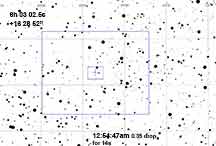

Doris is a large asteroid and we're in the center of the path so this one's a "sure thing". But the drop is only 0.35 mag and the target + asteroid is 12.25 magnitude, dropping to 12.6 for 14 seconds. It'll be hard to get any separation from Kirk Bender w/o large travel which is not justified. I will plan to try it from UCSC. The Alt=20, Az=276 in the west.
 |
 |
I recorded the occultation, saw the the fade as it happened, looked about the predicted length of time. The seeing was excellent and steady. I observed from just off the bike path crossing behind the Arboretum, which turned out to be a great spot for future events and photography. No troubles with private property, and the sky to the west has an excellent horizon. Only the SE has a big tree which would interfere with observing. The recording was successful and on transferring to my external HDD, the occultation was clearly visible visually.
I used 16x setting (about 1/3s integrations), and TME apertures (size=10), on the target, on the very similar nearby neighbor (ref1) and a more distant ref2, using both ref1 and ref2 as tracking apertures as well. Video was quite steady, and to my eye, no clouds. I had a remarkable experience with the reductions. The video showed more scatter to my mind than seemed visible on Kirk's video at a higher cadence. What was remarkable was that using a very low smoothing=6, which showed a lot of short term wiggle in the reference star, was the one which very clearly minimized the scatter in the target star and brought out the occultation much more clearly. I don't know if there was some sort of ~2s period noise picked up by both ref1 and the target in resonance, or whether it's an artifact of the TME aperture. Reductions appear pretty solid, for only a 0.25 magnitude drop.
magDrop report: percentDrop: 20.4 magDrop: 0.247 +/- 0.034 (0.95 ci)
DNR: 2.24
D time: [07:54:38.0388]
D: 0.6800 containment intervals: {+/- 0.2096} seconds
D: 0.9500 containment intervals: {+/- 0.9043} seconds
D: 0.9973 containment intervals: {+/- 2.3469} seconds
R time: [07:54:56.5987]
R: 0.6800 containment intervals: {+/- 0.2096} seconds
R: 0.9500 containment intervals: {+/- 0.9043} seconds
R: 0.9973 containment intervals: {+/- 2.3469} seconds
Duration (R - D): 18.5599 seconds
Duration: 0.6800 containment intervals: {+/- 0.3880} seconds
Duration: 0.9500 containment intervals: {+/- 1.2729} seconds
Duration: 0.9973 containment intervals: {+/- 2.8322} seconds
|
Zoomed in. There's a hint of a 2-step occultaton, but not on the PyMovie raw plot. Real? Hard to say. |
Observed from "the Berm" on Empire Grade just below Felton-Empire junction. This is about 3 or 4 miles north of the main UCSC campus. Good conditions, clear skies. I got a 17.75 sec event for Doris at 8x. I tried both TME and static circular apertures, I got slightly better DNR and containment intervals for static circular, that's what I'll report.